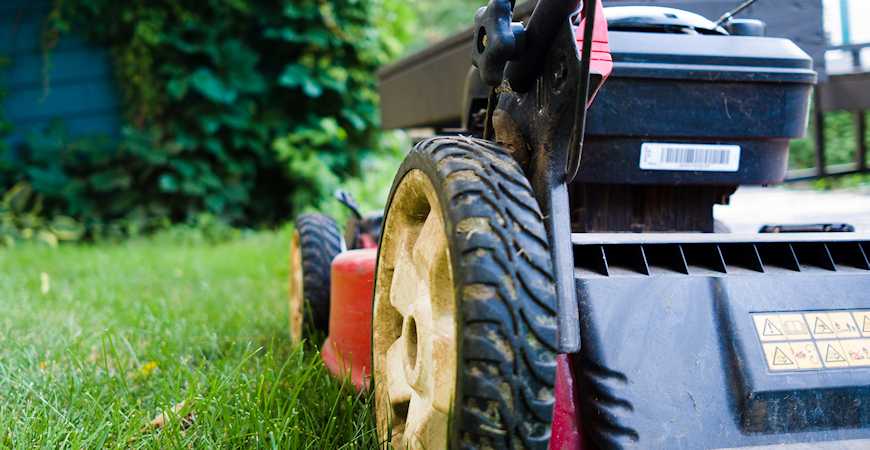
Pick the Best Lawn Mower for a Gorgeous, Stress-Free Lawn
Your lawn mower is your most important tool for keeping your lawn beautiful. More importantly, you’ll be using your lawn mower once a week or so all summer long, so you want a tool that makes your job easier, not a high-maintenance heap of metal that you have to fight against.
Use this handy guide to pick the right lawnmower for your needs and make lawn care a breeze this season!
Push Mowers
A push mower will do the trick if you have a small lawn. Consumer Reports say that a push mower is just fine for properties up to half an acre in size, and some homeowners use push mowers for properties up to an acre.
Anything bigger, and you’ll probably need to add a riding mower.
Here are the types of push mowers available:
Reel Mowers
These are the old-fashioned, elbow-grease-powered mowers with the barrel-shaped blade attached to two wheels.
The Upside: They are obviously the greenest choice out of all lawn mower types and are also the quietest. They will save you money on fuel, electricity, and maintenance.
These very basic mowers also cost less to buy than other models.
The Downside: These mowers don’t handle tall grass well and will easily become clogged by twigs, so they aren’t a very good option if you have a tough lawn or a lot of trees. They also don’t do anything with the clippings, so you will need to either rake them up or deal with the mess.
The Takehome: These mowers work best on very small, flat lawns with high-quality grass and few or no trees.
Electric Mowers
Some electric mowers have cords, and some cordless models use lithium-ion batteries.
The Upside: Electric mowers are quieter and less expensive than gas models and don’t expel the fumes that gas mowers do.
Concern about the negative impact of gas mowers on air quality has even motivated some communities to offer mower exchanges that allow you to exchange your gas mower for an electric mower and earn a large discount.
Electric mowers can also cost a lot less to operate with gas prices on the rise, and the maintenance on electric mowers tends to cost less than gas models.
The Downside: If you have a corded model, you can’t get too far from an electrical outlet and have to be careful of the cord.
The rechargeable mowers eliminate that problem, but some consumers have complained that some battery-operated mowers take a long time to charge and don’t operate well under hot sunlight, which seems to affect the battery in certain models.
Electric mowers are also less powerful than gas mowers, so they aren’t the best choice if you have thick grass or a tendency to procrastinate with your mowing.
The Takehome: Corded electric mowers are good money-savers for people with small lawns and good access to electrical outlets. Rechargeable models are a good electric mower option for people who want an electric mower but don’t have good access to electrical outlets but may take a long time to charge and are probably best for shadier lawns.
Gas Mowers
Gas mowers are the most popular lawn mowers, and their racket is one of the “songs” of summer. Here’s some information about gas push mowers.
The Upside: Gas mowers are the most powerful mowers available, so they are the best option if you have tough grass or a tendency to let your grass get tall. Gas mowers are also available in self-propelled models, which is a real back-and-arm-saver if you have a steep slope on your property.
You can also choose a bagless, bagging, or mulching mower; mulching mowers return nutrients from the grass to the soil, don’t leave you with waste to deal with, and can also mulch leaves in the fall.
The Downside: Gas mowers are very loud. All of the gas mowers that Consumer Reports tested emitted more than 85 decibels of noise; OSHA regulations require that workers exposed to 85 decibels or higher wear protective gear to avoid hearing loss.
They also emit fumes that are unhealthy for you and bad for the environment; in 2009, the Texas Commission on Environmental Air Quality found that one hour of mowing with a gas mower produces the same amount of air pollution as four hours of driving a car.
Gas mowers are the most expensive mowers to buy and maintain, and the gas isn’t cheap, either.
The Takehome: The power of a gas mower is probably necessary if you have very thick grass or if your grass often gets tall, and a self-propelled mower is best for sloped properties.
Riding Mowers
You’ll probably need a riding mower if your property is an acre or larger. Some people also need a push mower for tight spaces, but a riding mower will allow you to cut your lawn without being out there all day and coming in sweat-soaked and exhausted.
Here’s some information about riding mowers.
Lawn Tractors
Lawn tractors are the most common type of home-riding lawnmower. They are front-engine machines with four wheels.
The Upside: Lawn tractors are the least expensive type of riding lawnmower. They drive a lot like a car, so it is easy to learn how to operate.
Some models mulch lawn clippings, and others offer kits to bag clippings. Some models offer 4-wheel steering for tighter turning.
All lawn tractors can have snowblower attachments put on them for snow removal.
The Downside: Lawn tractors with 4-wheel steering cost more than those with 2-wheel steering, and they still can’t turn as tightly as zero-turn-radius mowers. Bagging kits are also pretty expensive, so most people stick with mulching or side-expelling their lawn clippings.
Snowblower attachments are also generally expensive. Lawn tractors also require a lot of storage space: about 4 by 6 feet for most models.
The Takehome: Lawn tractors are a relatively inexpensive option for people with larger properties, as long as you don’t have a lot of intricate landscaping that you will have to maneuver around.
Zero-Turn-Radius Mowers
You often see professional landscapers zipping around on these riding mowers, using steering levers and turning circles.
The Upside: These mowers are perfect for maneuvering around landscaping features, such as a lot of small trees or intricate flower groupings. They can turn circles and reverse directions quickly. You can mulch, side-expel, or bag clippings.
The Downside: Zero-turn-radius mowers cost more than lawn tractors, and, according to Consumer Reports, they often don’t cut the grass as neatly. Consumer Reports says that their rear-steering wheels can sometimes tear grass during turning.
It also takes a while to get used to using the lever system to steer these mowers because it’s a lot different from anything that most people have used before. As with lawn tractors, bagging kits tend to be expensive.
This type of mower is also difficult to control on hills.
The Takehome: Zero-turn-radius-mowers is an option if you have a large, flat property with many obstacles, but you might also want to consider a 4-wheel-steering lawn tractor.
About the Engine…
The engines on gas mowers come with torque and horsepower ratings, but Consumer Reports found that these numbers didn’t seem to translate into performance on the ground. In general higher torque and higher horsepower mean a more powerful engine, but a lot more factors go into making a high-performing machine.
Before you make a big purchase such as a lawnmower, it’s always a good idea to check with trusted sites such as Consumer Reports.
Once you’ve narrowed your search down to a few models that you’re considering, a good way to get free reviews is to go onto sites such as Amazon.com as well as the websites for any home improvement store or another store that sells the mower you’re considering and read the customer reviews for the mower.
It takes a little time, but you can learn valuable information from people who already have the mower you’re looking at.
Pick the right mower to master your lawn and spend time cooking out this summer, not fighting with your mower!
Photos courtesy of Phil Roeder, Edwin and Kelly Tofslie, and James Lee.











